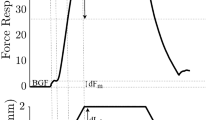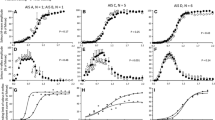Abstract
The purpose of this study was to examine the reflex effects of electrical stimulation applied to the thigh using skin electrodes, targeting the sensory fibers of the rectus femoris and sartorius, in people with spinal cord injury (SCI). Thirteen individuals with SCI were recruited to participate in experiments using prolonged electrical stimuli on the right medial thigh over the regions of the sartorius and rectus femoris muscles. Three stimuli, spaced 20 s apart, were applied at 30 Hz for 1 s at four different intensities (15–60 mA) while subjects rested in a seated position. Isometric joint torques of the hip, knee and ankle, and electromyograms (EMGs) from six muscles of the leg were recorded during the stimulation. Early in the stimulation, a flexion response was observed at the hip and ankle, analogous to a flexor reflex; however, this response was usually followed by a “rebound” response consisting of hip extension, knee flexion and ankle plantarflexion, occurring in 10/13 subjects. Stimuli applied in a more lateral (mid thigh) electrode position (i.e. over the rectus femoris) were less effective in producing the response than medial placement, despite vigorous quadriceps activation. This complex reflex response is consistent with activation of a coordinating spinal circuit that could play a role in motor function. The reversal of the reflex pattern emphasizes the potential connection between skin/muscle afferents of the thigh, possibly including sartorius muscle afferents and locomotor reflex centers. This knowledge may be helpful in identifying rehabilitation strategies for enhancing gait training in human SCI.





Similar content being viewed by others
References
Andersen OK, Finnerup NB, Spaich EG, Jensen TS, Arendt-Nielsen L (2004) Expansion of nociceptive withdrawal reflex receptive fields in spinal cord injured humans. Clin Neurophysiol 115:2798–2810
Benz EN, Hornby TG, Bode RK, Scheidt RA, Schmit BD (2005) A physiologically based clinical measure for spastic reflexes in spinal cord injury. Arch Phys Med Rehabil 86:52–59
Brown TG, Sherrington CS (1912) The rule of reflex response in the limb reflexes of the mammal and its exceptions. J Physiol 44:125–130
Burke RE (1999) The use of state-dependent modulation of spinal reflexes as a tool to investigate the organization of spinal interneurons. Exp Brain Res 128:263–277
Bussel B, Roby-Brami A, Yakovleff A, Bennis N (1989) Late flexor reflex in paraplegic patients. Evidence for a spinal stepping generator. Brain Res Bull 22:53–56
Calancie B, Needham-Shropshire B, Jacobs P, Willer K, Zych G, Green BA (1994) Involuntary stepping after chronic spinal cord injury. Evidence for a central rhythm generator for locomotion in man. Brain 117:1143–1159
Denny-Brown D (1940) Selected writings of Sir Charles Sherrington. Paul B. Hoeber, Inc, New York
Deutsch KM, Hornby TG, Schmit BD (2005) The intralimb coordination of the flexor reflex response is altered in chronic human spinal cord injury. Neurosci Lett 380:305–310
Dietz V (1995) Locomotor training in paraplegic patients. Ann Neurol 38:965
Dietz V, Muller R, Colombo G (2002) Locomotor activity in spinal man: significance of afferent input from joint and load receptors. Brain 125:2626–2634
Eccles RM, Lundberg A (1959) Synaptic actions in motoneurones by afferents which may evoke the flexion reflex. Arch Ital Biol 9:199–211
Field-Fote EC (2001) Combined use of body weight support, functional electric stimulation, and treadmill training to improve walking ability in individuals with chronic incomplete spinal cord injury. Arch Phys Med Rehabil 82:818–824
Gregoric M (1998) Suppression of flexor reflex by transcutaneous electrical nerve stimulation in spinal cord injured patients. Muscle Nerve 21:166–172
Grillner S, Rossignol S (1978) On the initiation of the swing phase of locomotion in chronic spinal cats. Brain Res 146:269–277
Harkema SJ, Hurley SL, Patel UK, Requejo PS, Dobkin BH, Edgerton VR (1997) Human lumbosacral spinal cord interprets loading during stepping. J Neurophysiol 77:797–811
Harvey PJ, Li X, Li Y, Bennett DJ (2006) Endogenous monoamine receptor activation is essential for enabling persistent sodium currents and repetitive firing in rat spinal motoneurons. J Neurophysiol 96:1171–1186
Heckman CJ (1994) Alterations in synaptic input to motoneurons during partial spinal cord injury. Med Sci Sports Exerc 26:1480–1490
Hiebert GW, Whelan PJ, Prochazka A, Pearson KG (1996) Contribution of hind limb flexor muscle afferents to the timing of phase transitions in the cat step cycle. J Neurophysiol 75:1126–1137
Hiersemenzel LP, Curt A, Dietz V (2000) From spinal shock to spasticity: neuronal adaptations to a spinal cord injury. Neurology 54:1574–1582
Hornby TG, Tysseling-Mattiace VM, Benz EN, Schmit BD (2004) Contribution of muscle afferents to prolonged flexion withdrawal reflexes in human spinal cord injury. J Neurophysiol 92:3375–3384
Hornby TG, Kahn JH, Wu M, Schmit BD (2006) Temporal facilitation of spastic stretch reflexes following human spinal cord injury. J Physiol 571:593–604
Hornby TG, Rymer WZ, Benz EN, Schmit BD (2003) Windup of flexion reflexes in chronic human spinal cord injury: A marker for neuronal plateau potentials? J Neurophysiol 89:416–426
Jankowska E, Lundberg A (1981) Inter neurons in the spinal cord. Trends Neurosci 4:230–233
Jankowska E, Jukes MG, Lund S, Lundberg A (1967a) The effect of DOPA on the spinal cord. 5. Reciprocal organization of pathways transmitting excitatory action to alpha motoneurones of flexors and extensors. Acta Physiol Scand 70:369–388
Jankowska E, Jukes MG, Lund S, Lundberg A (1967b) The effect of DOPA on the spinal cord. 6. Half-centre organization of interneurones transmitting effects from the flexor reflex afferents. Acta Physiol Scand 70:389–402
Jankowska E (1992) Interneuronal relay in spinal pathways from proprioceptors. Prog Neurobiol. 38:335–378
Kriellaars DJ, Brownstone R, Noga BR, Jordan LM (1994) Mechanical entrainment of fictive locomotion in the decerebrate cat. J Neurophysiol 71:2074–2086
Lam T, Pearson KG (2001) Proprioceptive modulation of hip flexor activity during the swing phase of locomotion in decerebrate cats. J Neurophysiol 86:1321–1332
Lam T, Pearson KG (2002) Sartorius muscle afferents influence the amplitude and timing of flexor activity in walking decerebrate cats. Exp Brain Res 147:175–185
Lundberg A (1979) Multisensory control of spinal reflex pathways. Reflex control of posture and movement. Prog Brain Res 50:11–28
Nickolls P, Collins DF, Gorman RB, Burke D, Gandevia SC (2004) Forces consistent with plateau-like behaviour of spinal neurons evoked in patients with spinal cord injuries. Brain 127:660–670
Onushko T, Schmit BD (2007) Reflex responses to imposed bilateral hip oscillations in human spinal cord injury. J Neurophysiol 98:1849–1861
Pang MY, Yang JF (2000) The initiation of the swing phase in human infant stepping: importance of hip position and leg loading. J Physiol 528:389–404
Pearson KG, Rossignol S (1991) Fictive motor patterns in chronic spinal cats. J Neurophysiol 66:1874–1887
Pépin A, Ladouceur M, Barbeau H (2003) Treadmill walking in incomplete spinal-cord-injured subjects: 2. Factors limiting the maximal speed. Spinal Cord 41:271–279
Sandrini G, Serrao M, Rossi P, Romaniello A, Cruccu G, Willer JC (2005) The lower limb flexor reflex in humans. Prog Neurobiol 77:353–395
Schindler-Ivens SM, Shields RK (2004) Soleus H-reflex recruitment is not altered in persons with chronic spinal cord injury. Arch Phys Med Rehabil 85:840–847
Schmit BD, McKenna-Cole A, Rymer WZ (2000) Flexor reflexes in chronic spinal cord injury triggered by imposed ankle rotation. Muscle Nerve 23:793–803
Schmit BD, Benz EN (2002) Extensor reflexes in human spinal cord injury: activation by hip proprioceptors. Exp Brain Res 145:520–527
Schmit BD, Hornby TG, Tysseling-Mattiace VM, Benz EN (2003) Absence of local sign withdrawal in chronic human spinal cord injury. J Neurophysiol 90:3232–3241
Shahani BT, Young RR (1971) Human flexor reflexes. J Neurol Neurosurg Psychiatry 34:616–627
Shahani BT, Young RR (1974) Management of flexor spasms with Lioresal. Arch Phys Med Rehabil 55:465–467
Sherrington C (1906) On the innervation of antagonistic muscles. Ninth notes. Successive spinal induction. Proc Roy Soc 77B:478–497
Sherrington C (1910) Flexion reflex of the limb, crossed extension–flexion, and reflex stepping and standing. J Physiol 40:28–121
Steldt RS, Schmit BD (2004) Modulation of coordinated muscle activity during imposed sinusoidal hip movements in human spinal cord injury. J Neurophysiol 92:673–685
Theiss RD, Kuo JJ, Heckman CJ (2007) Persistent inward currents in rat ventral horn neurones. J Physiol 580(Pt. 2):507–522
Van de Crommert HW, Steijvers PJ, Mulder T, Duysens J (2003) Suppressive musculocutaneous reflexes in tibialis anterior following upper leg stimulation at the end of the swing phase. Exp Brain Res 149:405–412
Winter DA (1991) Biomechanics and motor control of human gait: normal, elderly and pathological, 2nd edn. Waterloo Biomechanics, Waterloo
Wu M, Hornby TG, Hilb J, Schmit BD (2005) Extensor spasms triggered by imposed knee extension in chronic human spinal cord injury. Exp Brain Res 162:239–249
Wu M, Hornby TG, Kahn JH, Schmit BD (2006) Flexor reflex responses triggered by imposed knee extension in chronic human spinal cord injury. Exp Brain Res 168:566–576
Zehr EP, Stein RB (1999) What functions do reflexes serve during human locomotion? Prog Neurobiol 58:185–205
Acknowledgments
This work is supported by the NIDRR Switzer Distinguished Research Fellowship, H133F050031 and PVA Research Foundation Grant, 2447.
Author information
Authors and Affiliations
Corresponding author
Appendix
Appendix
-
1.
ASIA impairment scale:
- A = Complete.:
-
No Sensory or motor function preserved in sacral segments S4-S5.
- B = Incomplete.:
-
Sensory but not motor function preserved below neurological level and extends through S4–S5.
- C = Incomplete.:
-
Motor function preserved below neurological level and through S4–S5.
- :
-
Majority of Key muscles below neurological level have a grade less than 3.
- D = Incomplete.:
-
Motor function preserved below neurological level and through S4–S5.
- :
-
Majority of Key muscles below neurological level have a grade at least 3.
- E = Normal.:
-
Sensory and Motor function is normal.
-
2.
The transformation matrix relating the measured torque and force of the 6-DOF load cell to the torques of each joint.
where a 11 = l s sinθ a + l t sin(θ k − θ a); a 12 = −l s cosθ a + l t cos(θ k − θ a); a 13 = 1; a 21 = −l s sinθ a; a 22 = l s cosθ a; a 23 = −1; a 31 = 0; a 32 = 0; a 33 = 1. l t was the length of the femur, and l s was the length between the ankle and knee axes of rotation (as shown in Fig. 1). θ k was the angle of knee joint, while θ a was the angle of ankle joint, which is indicated in Table 2 for each subject. The forces and torqueF xc , F yc , τ zc were measured using the 6-DOF load cell. The calculation using this matrix yielded the joint torques τ h, τ k, τ a for hip, knee and ankle joints respectively.
Rights and permissions
About this article
Cite this article
Wu, M., Kahn, J.H., Hornby, T.G. et al. Rebound responses to prolonged flexor reflex stimuli in human spinal cord injury. Exp Brain Res 193, 225–237 (2009). https://doi.org/10.1007/s00221-008-1614-3
Received:
Accepted:
Published:
Issue Date:
DOI: https://doi.org/10.1007/s00221-008-1614-3




